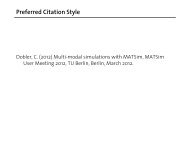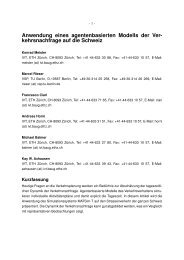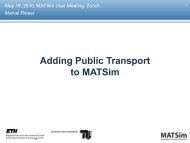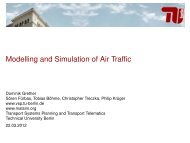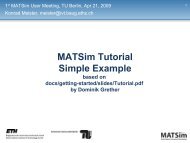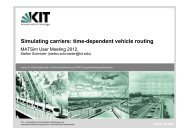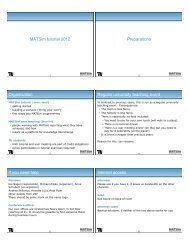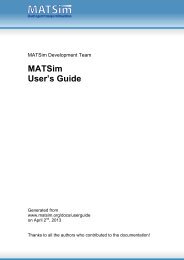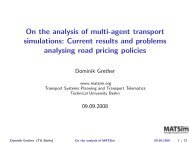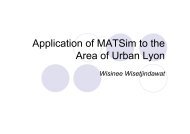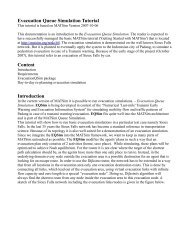LARGE-SCALE PARALLEL GRAPH-BASED SIMULATIONS - MATSim
LARGE-SCALE PARALLEL GRAPH-BASED SIMULATIONS - MATSim
LARGE-SCALE PARALLEL GRAPH-BASED SIMULATIONS - MATSim
You also want an ePaper? Increase the reach of your titles
YUMPU automatically turns print PDFs into web optimized ePapers that Google loves.
Algorithm 5 for Vehicle Movement through Intersections:<br />
for all nodes do<br />
if node visited for the first time then<br />
Choose first incoming link randomly according to capacity<br />
end if<br />
for i = 1..(the number of incoming links) do<br />
Choose next incoming link via Metropolis sampling<br />
if link buffer is empty then<br />
Mark link as non-eligible<br />
else<br />
Take first vehicle in the buffer<br />
if destination link for vehicle has space then<br />
Move that vehicle from buffer to destination link<br />
else<br />
Mark link as non-eligible<br />
end if<br />
end if<br />
end for<br />
end for<br />
Figure 2.7: Handling intersections according to the modified Metropolis sampling.<br />
Finally, Algorithm-5 is similar to Algorithm-4 except that if a node is visited for the first<br />
time, the first incoming link is selected according to the flow capacity. The algorithm is given<br />
in Figure 2.7.<br />
The queue model reads flow capacities, free speeds and link lengths, from the input files<br />
and accordingly calculates free flow link travel times. The free flow link travel time defines<br />
the minimum time that vehicles on that particular link must spend. Whilst the lower-bound is<br />
known, the upper-bound for a vehicle being on a link before moving to the next link depends on<br />
how long the vehicle waits at the end of the link. If the randomized selection is not in favor of<br />
a link on which a vehicle is ready to move to the next link (Figure 2.3), the travel time related<br />
to the link increases.<br />
There is a remark to be made about flow capacities. When several of very short links (such<br />
as links with a buffer size 1) exist, they reduce the number of vehicles discharge from the longer<br />
links as the available space is reduced by the short links 2 .<br />
2.2.3 Graph Data as Input for Queue Simulation<br />
The traffic flow simulation is fed by the graph data (the street network) and the plans of vehicles<br />
to be executed. Plans are explained in Section 2.2.4. Before the execution of plans, the<br />
simulation reads nodes and links of the street network. The street network is defined in the<br />
XML [97] format and a rough example is shown in Figure 2.8. XML is explained in detail in<br />
2 The problem can be seen as follows: Assume a short link with a given non-integer capacity (per second), with<br />
long links of the same capacity both upstream and downstream. Then, according to standard queuing theory, the<br />
queue length on the short link follows a random walk. However, when that random walk makes the short link<br />
completely full, then the upstream link is no longer allowed to discharge into the short link. Since this happens<br />
fairly often with short links, this means that short links reduce the effective capacity. Note that the effective<br />
capacity reduction is felt for the upstream link. This phenomenon has little effect with the long links of the Swiss<br />
street network defined in Section 2.5, but became apparent with validation studies with the Navtec network of the<br />
Zurich area, which has many short links.<br />
11



